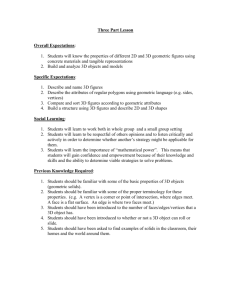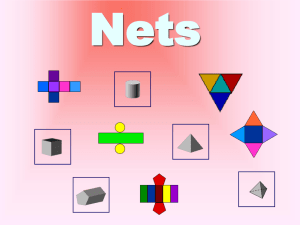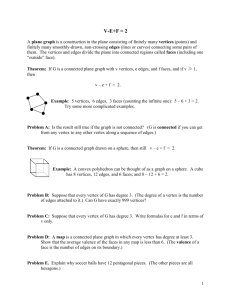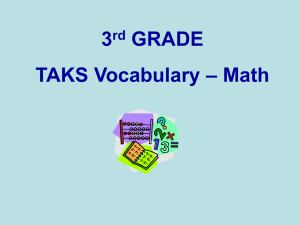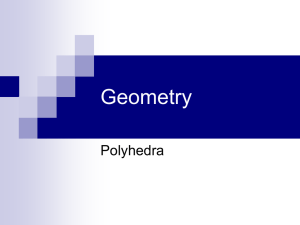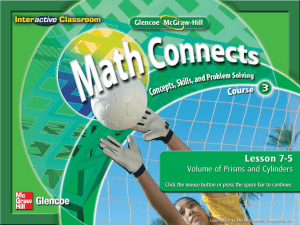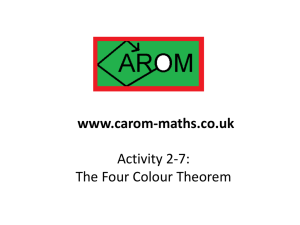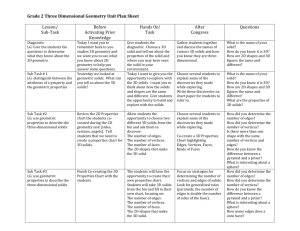Lesson Plan
advertisement
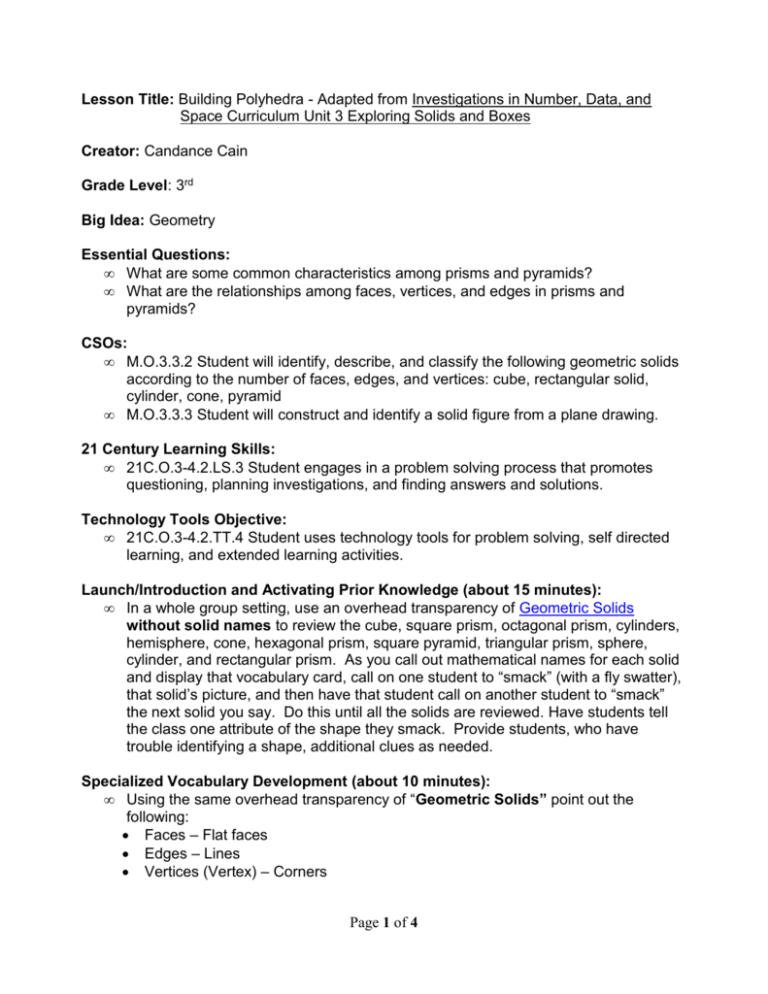
Lesson Title: Building Polyhedra - Adapted from Investigations in Number, Data, and Space Curriculum Unit 3 Exploring Solids and Boxes Creator: Candance Cain Grade Level: 3rd Big Idea: Geometry Essential Questions: What are some common characteristics among prisms and pyramids? What are the relationships among faces, vertices, and edges in prisms and pyramids? CSOs: M.O.3.3.2 Student will identify, describe, and classify the following geometric solids according to the number of faces, edges, and vertices: cube, rectangular solid, cylinder, cone, pyramid M.O.3.3.3 Student will construct and identify a solid figure from a plane drawing. 21 Century Learning Skills: 21C.O.3-4.2.LS.3 Student engages in a problem solving process that promotes questioning, planning investigations, and finding answers and solutions. Technology Tools Objective: 21C.O.3-4.2.TT.4 Student uses technology tools for problem solving, self directed learning, and extended learning activities. Launch/Introduction and Activating Prior Knowledge (about 15 minutes): In a whole group setting, use an overhead transparency of Geometric Solids without solid names to review the cube, square prism, octagonal prism, cylinders, hemisphere, cone, hexagonal prism, square pyramid, triangular prism, sphere, cylinder, and rectangular prism. As you call out mathematical names for each solid and display that vocabulary card, call on one student to “smack” (with a fly swatter), that solid’s picture, and then have that student call on another student to “smack” the next solid you say. Do this until all the solids are reviewed. Have students tell the class one attribute of the shape they smack. Provide students, who have trouble identifying a shape, additional clues as needed. Specialized Vocabulary Development (about 10 minutes): Using the same overhead transparency of “Geometric Solids” point out the following: Faces – Flat faces Edges – Lines Vertices (Vertex) – Corners Page 1 of 4 Use colored markers or highlighting strips (colored plastic cut to the shape of some faces) to show faces, edges, and vertices as they are introduced. Display vocabulary cards for each term also. Have students point out real solids found in the classroom (i.e. - a TV for a rectangular prism) and indicate faces, edges, and vertices. Vocabulary learned prior to this lesson: Prior to this lesson students have explored, sorted, and talked about common geometric solids. In mathematics, these shapes are called “solids” whether they are filled or hollow. Investigate/Explore (suggested time 60-80 minutes): Explain to students that they will: 1. Work in pairs (chosen by the teacher) to build the solids we have been discussing. 2. Build polyhedra while looking at pictures or models. 3. Get a building kit with straws of different lengths/colors and connectors (pipe cleaners). 4. NOT bend the straws. 5. Need to determine which shapes they can build with the straws. 6. Need to talk with each other about the relationships among faces, edges, and vertices and how that knowledge will help them build their shape. 7. Record the number of faces, edges, and corners for each shape on the geometric solids sheet How Many Faces, Edges, and Vertices? 8. Each pair will need a building kit, connectors, and a geometric solids sheet How Many Faces, Edges, and Vertices? Divide students in pairs. Distribute materials Informally assess students while they are building the solids: Are they able to build the shapes? Encourage students having difficulty to use the wooden shapes as a 3D model instead of pictures. Do students quickly distinguish between the figures they can (polyhedra) and cannot build (non-polyhedra)? Are they accurately counting the faces, edges, and vertices? You might demonstrate organized thinking during counting or have them watch others. Have students tell you what strategies they used to build and count. Do students use appropriate mathematical vocabulary for critical attributes? Encourage students to use the geometric names. While students are working in pairs and you move from group to group ask students the following questions: Can you build all the shapes? Why not? Which have the most/least faces? Show me how you counted the faces, edges, and vertices. Page 2 of 4 Why do you think the octagonal prism has more faces than the triangular prism? Can you tell me how a pyramid is like and/or unlike a prism? Have you found any similarities among any of the shapes you have made? *Optional* (When individuals finish and others are still working) Using the Internet go to the following site: http://nlvm.usu.edu/en/nav/frames_asid_128_g_2_t_3.html?open=instructions&from =topic_t_3.html You can click on the close button in the box to the right to make the area larger Use one finger to hold down your left mouse button and another finger to move the cursor (hand) over the triangular pyramid Move the shape to view different sides Hold the shift key, click a color button, and click a side to change the color, do this with all sides. Click on the lines to view edges Click on the corners to view vertices Notice how the shapes connect to make up the solid Notice when you click on a side, line, or corner the program counts these for you Summarize/Debrief the Lesson (suggested time about 30 minutes): 1. Bring students back together. 2. Have them share their ideas about constructing the shapes. 3. Ask students which shapes they were able to build and which ones they couldn’t build. 4. Encourage students to model and talk about strategies they used to keep track of counting the faces, edges, and vertices. 5. Ask students to share any common characteristics they found among prisms and pyramids. 6. Ask students what similarities and differences they found among any of the shapes they made. Reflections: Finish by asking students “What are the relationships you found between the number of edges and faces with some of the polyhedra?” Have students share and check their answers for each shape on the geometric solids sheet “How Many Faces, Edges, and Vertices?” Materials: Vocabulary cards with the names (cube, square prism, octagonal prism, cylinders, hemisphere, cone, hexagonal prism, square pyramid, triangular prism, sphere, cylinder, rectangular prism, faces, edges, vertex, and vertices. Geometric Solids Models (wooden or plastic) Geometric Solids without solid names (transparency) Geometric Solids with solid names (transparency) Page 3 of 4 How Many Faces, Edges, and Vertices? sheet Building Straws of different colors and lengths: o 10 at 2 inches o 15 at 3 inches o 20 at 4 inches o 19 at 5 inches o 10 at 6 inches o 10 at 8 inches Pipe cleaners cut to about 1-1/2 inches to use as connectors (200-300) Different colored overhead markers Overhead Projector Duration: About 2 – 2 ½ hours Teacher Notes: Terminology: It is not critical for students to memorize all the terminology used in this lesson. However, you should know and use the correct terminology, along with those used by students to familiarize students with the correct terms. For instance, a student generating a term such as a 3-dimensional shape with flat sides could be told that mathematicians call these shapes polyhedra. Students may frequently use corner for vertex, line for edge, and side for face. Building straws – I use a kit that came with my Investigations manipulatives. You could take any straight straws (not bendable) and cut them to the lengths above. Thin straws work better. If you can’t find straws of different colors you could just color code each length with a marker, paint, or nail polish. Connectors: I just took pipe cleaners and cut them into small pieces (about an inch to inch and a half). These worked perfectly as connectors. Time: In the past it has taken up to two math periods for the students to build all of the solids. Summarizing is very important to follow up with a discussion and have students share methods for finding and describing the faces, edges, and vertices. Page 4 of 4
